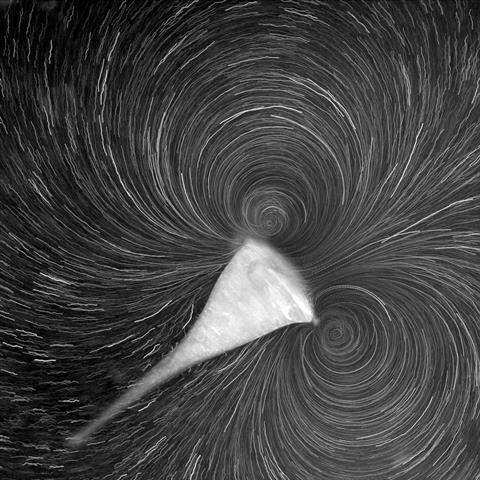Humans like to think that being multicellular (and bigger) is a definite advantage, even though 80 per cent of life on Earth consists of single-celled organisms – some thriving in conditions lethal to any beast.

In fact, why and how multicellular life evolved has long puzzled biologists. The first known instance of multicellularity was about 2.5 billion years ago, when marine cells (cyanobacteria) hooked up to form filamentous colonies. How this transition occurred and the benefits it accrued to the cells, though, is less than clear.
READ MORE: Tiny microbe colonies communicate to coordinate their behavior
READ MORE: Multicellular organisms require significantly more energy than single-celled ones
This week, a study originating from the Marine Biological Laboratory (MBL) presents a striking example of cooperative organization among cells as a potential force in the evolution of multicellular life. Based on the fluid dynamics of cooperative feeding by Stentor, a relatively giant unicellular organism, the report is published in Nature Physics.
Step back in evolution
“We took a step back in evolution, to when organisms were independent. Why did they even come together in a colony before they ever became fixed in position relative to each other?” says John Costello of Providence College, senior author on the study and an MBL Whitman Center scientist along with co-author Sean Colin of Roger Williams University.
“So much work on the origin of multicellular life focuses on chemistry. We wanted to investigate the role of physical forces in the process,” says lead author Shashank Shekhar, Assistant Professor of Physics at Emory University and a former Whitman Center Early Career Awardee at MBL.
Stentor is a trumpet-shaped, single-celled organism that can grow up to 2 mm long. In its native habitat of ponds or lakes, Stentor attaches its slender end (called the holdfast) to leaves or twigs while the trumpet end sways freely, creating a vortex of water to suck in food, such as bacteria, with its cilia-lined mouth.
Working in harmony
In the lab, the scientists noted, when Stentors are dropped into a dish of pond water, they quickly form a dynamic colony where the cells don’t actually attach to one other, but their holdfasts touch together on the glass. By quantifying fluid flows, the team showed that two neighboring Stentors in a colony can double the flow rate of water into their mouths, as compared to their individual capacity. This allows them to suck in more prey and faster-swimming prey, by creating stronger vortexes that sweep in water from a greater distance.
However, the feeding benefits accrued by two neighboring Stentor aren’t equal, the team found. The weaker Stentor gains more from teaming up than the stronger one does. And, curiously, they display what Shekhar calls “she loves me, she loves me not” behavior. When paired Stentors sway their trumpet ends together, their fluid flows increase, but then they invariably oscillate, pulling their mouths apart again. Why?
Fluid dynamics
To answer this, they turned to mathematical modeling of fluid dynamics across the colony led by co-authors Hanliang Guo of Ohio Wesleyan University and Eva Kanso of University of Southern California.
Guo and Kanso confirmed a ‘promiscuity’ in the colony, where individuals keep switching between neighboring partners. And the result is all the cells in a Stentor colony, on average, gain stronger feeding flows.
“In a colony, even though an individual might appear to be moving away from one neighbor, it is actually moving closer to another neighbor,” the team writes. This makes sense from an evolutionary standpoint, “as individuals are expected to seek the most favorable energetic payoff by associating with a neighboring individual that benefits them most.”
“You might look at them as always attempting to optimize their income,” Costello says. And the colony as a whole reaps more food.
Just a phase
But wait. The Stentor we know and love today is not multicellular. The colonies it forms are ephemeral; they disperse just by bumping the lab table. If the individuals collectively benefit from working together, why do they separate again?
The scientists don’t know for sure. But they’ve noted that when they give Stentors plenty of food, they are happy to remain attached to the glass and feed in colonies. But when the food is taken away and becomes scarce, the Stentors detach and go into individual foraging mode.
“Humans do that, too,” Shekhar says. “When there are plenty of resources and prey, we collaborate and cooperate. But when the resources reduce, it’s each one to its own.”
We are not clones
In other models of early multicellular life, such as the green algae Volvox cateri, cells that failed to divide properly eventually evolved a matrix between them, forming a colony of genetically identical cells which later differentiated. But the ephemeral Stentor colonies are formed not of clones, but of genetically distinct individuals.
That’s why the scientists think their Stentor model precedes other models of early multicellularity (which is believed to have evolved at least 25 times in different lineages).
“This is earlier, much earlier in evolution where happy single cells said, OK, let’s hang out together and benefit, but then let’s go back to being single again. Multicellularity wasn’t done permanently yet,” says Shekhar.
Shekhar began this study as a student in the 2014 MBL Physiology course with then course co-director Wallace Marshall of University of California, San Francisco, an expert on Stentor.
Topics
- Clean Water
- cooperative feeding
- Ecology & Evolution
- Emory University
- Eva Kanso
- fluid dynamics
- Hanliang Guo
- Healthy Land
- John Costello
- Marine Biological Laboratory
- multicellularity
- Ohio Wesleyan University
- Providence College
- Research News
- Roger Williams University
- Sean Colin
- Shashank Shekhar
- Stentor
- University of California, San Francisco
- University of Southern California
- USA & Canada
- Wallace Marshall







No comments yet